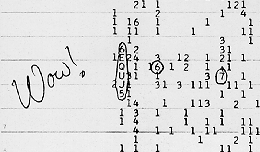James Brown continues to run SETI.net, a privately-funded SETI search program using off-the-shelf components and software created by himself. Brown’s work may well be unique, for there seems to be no other working station collecting data that is run by amateur radio astronomers, and that poses a problem for observations like the recent series Brown has made at the frequency and coordinates of the so-called ‘Wow Signal,’ which was received just over thirty years ago on August 15, 1977.

The problem, of course, is that when Brown notes something of interest, he needs corroboration. If you are in the ranks of amateur SETI or radio astronomy enthusiasts and can coordinate observations with SETI.net, you’ll want to check Brown’s recent work (scroll to the bottom of the page) and contact him for further information. The Wow Signal was detected by Jerry Ehman at the Ohio State University Radio Observatory (known as the Big Ear). The signal, strong enough to elicit Ehman’s inscribed comment on the printout, was never repeated.
An interstellar beacon? Ehman came to believe that more prosaic explanations account for the signal, including the possibility of a signal bounce off space debris. But have a look at his complete writeup of the matter, which goes through the entire range of alternative explanations. And if this singular reception still intrigues you and you’ve got the expertise, consider how you might contribute to amateur SETI directly.


Ehman doesn’t seem to address the possibility that the signal came from some unusual, or at least hard-to-observe, physical process. How much do we know about such things? Have other surveys put useful limits on things like this? He doesn’t seem to mention other related observing programs at all.
And if I were referee on this paper, I’d definitely recommend some figures. Light curves and error ellipses and so on.
I read a version of this article (can’t find the page anymore) but I remember it said that 6EQUJ5 was the the definition of nitrogen or something like that. As much as I would like to believe that we are not alone, with the equipment used 30 years ago compared to the equipment used today, there was a lot of room for error. Since we will never know what this was, I have to believe it was “space noise” and nothing more.
Tina, go to this section of Ehman’s article on the Wow! signal
to see what the “code” really means – essentially signal strength:
http://www.bigear.org/wow20th.htm#printout
WOW! I want to know what it said! I hope theres life out there besides us!
Also, I need a scientist/astronomer to interview for my project. Send a message to Jamie.Falgout@gmail.com, Thanks
One Man’s Quest for SETI’s Most Promising Signal
Jan. 27, 2012 | 14:29 PST | 22:29 UTC
Review of Robert H. Gray, The Elusive Wow: Searching for Extraterrestrial intelligence (Chicago: Palmer Square Press, 2011).
By Amir Alexander
The signal from the stars arrived at the Big Ear radio observatory in Ohio at 11:16 p.m. on the night of August 15, 1977. It came in loud and crisp, reaching at least 30 times the volume of the background noise and occupying a single 10 kilohertz-wide band on the observatory’s receiver. Its middle part lasted 38 seconds – the time it takes Big Ear’s radio band to traverse a single point in the sky – and it landed almost precisely at the frequency at which SETI scientists were hoping to find it: 1420 kilohertz, the emission frequency of hydrogen. It was exactly what SETI scientists had been waiting for – a seemingly artificial signal from the stars, one that could carry a message from alien beings light-years away.
No one was there to receive the signal when it came in. The telescope’s beam silently scanned the skies, the receiver and spectrometer registered and analyzed the data, and a printer rattled in the darkness, recording it all in a continuous stream of numbers and letters. But when Big Ear volunteer Jerry Ehman looked over the printout a few days later, the sequence recording the signal leaped off the page at him: 6 E Q U J 5. Ehman circled the sequence and in the margins jotted a pure, barely articulate, expression of wonder: “Wow!” That was the first time the Wow! signal was detected. To this day, it is also the last.
Full article here:
http://www.planetary.org/blog/article/00003346/